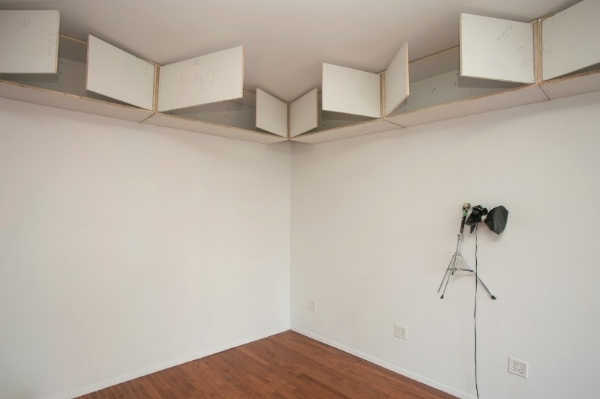There are a number of people making work right now that aptly dig holes into what a sculpture or installation can be, purposefully pointing fingers at the ways we encounter art in the round. I am thinking specifically about a show by Daniel Turner that is coming to an end at Team Gallery, an experience that just opened at Robert Blumenthal by Luke Diiorio, and an installation by Samuel Payne that is a little over half way through it’s duration at Peninsula Art Space in Redhook. It’s the work of this last artist that I think embodies the essence of what I find most relevant within this genre of recent art.
As you enter the space, the first thing you likely become aware of is 270 degrees of cabinet, hang half open all the way around the three available sides of the gallery. They are desperate to be touched, doors all ajar. Yet, as they are hung tight to the ceiling, they are definitely out of reach. To your left, a fedora lies abandoned, upside down, holding a set of gambling dice. It references the absence of the artist as much as it entices the viewer to take a chance in staying a minute or two to absorb the work
Straight ahead, a small amp feeds music from a song playing off of a video in the back room. It leans menacingly at an acute angle from the floor facing a simple paper snowflake, which is choked between two layers of suffocating plastic wrapped over what appears to be a modest set of stretcher bars.
A clamp light on a cymbal stand is hung and left for dead on the right wall, face removed of it’s utility by a heavy wrapping of black plastic. It hangs perilously close to the plug that can give it life, yet is helpless to plug itself in, cord lying limply against the ground in solemn defeat. This piece perhaps most obviously states the artist’s intention of removing the useful nature of a given object in order to imbue it with a new purpose that is divorced from the original use of the thing we comprehend.
In the back room, a floor installed TV plays a series of video clips recorded by the artist on a trip across the US. Each segment shows Payne hiding behind a series of plein air landscape paintings. He plays the soundtrack to the exhibition on his acoustic guitar, sliding behind the easel that faces the viewer to play his song before sneaking away upon its conclusion without ever showing his face to the camera. These songs slink throughout the airspace intermittently, becoming the cyclical soundtrack of the exhibition, which build and wane with each passing of a song dedicated to a very specific vista encountered in the artist’s journeys.
One of the most startlingly beautiful aspects of this work is the artist’s attention to local light and the passing of natural time. As the sun goes down, the lights of the neighborhood bleed in through the glass front windows. We become silhouettes on the back wall; flowing reds, greens, and grays making the cabinets shift and slowly move around us like imagined planes in an abstract painting. They also serve to show ourselves to ourselves, as we are active observers whose likenesses are projected throughout the space.
As an ambulance goes by our reality is kicked into an excited frenzy, colored fragments of light dancing frenetically throughout the space. It reveals the exhibition as a multifaceted camera obscura, reflecting the interior experience, while returning one’s thought to the fact that this all exists in a state of some slightly morbid, existential flux. The patient in the ambulance may be fine at the end of the day, but the work seems to nod as the blinking lights fly by, knowingly acknowledging the possibility of immanent defeat.
Here the objects have not only suffocated from being separated from their utility, literally choked out by an impenetrable material, but die an honorable death of some sort, limply giving themselves over to this other world of deceased presentation. They exude an understanding that the hereafter will provide the viewer some sort of way out, a means to understand a new reality of the object that may only exist within the mind of the spectator. This seems to be fine with Samuel Payne. He has created this environment after all, and wants it to be a slowly opening bloom of experience. Like the selenicereus grandiflorus, it may only be alive to the viewer for one night, but if it blooms at all, that will likely be enough.
By Matthew Hassell
























